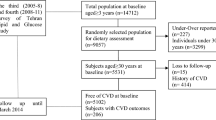Abstract
Objective: To study the influence of supplementation with antioxidants on factors, which might increase the risk of coronary heart disease (CHD) in Iranians. Design: Twenty-one male volunteers enter the prospective, single-blind, randomized study. Setting: The supplementation was conducted at the Cardiovascular Center, University of Tehran, the biochemical analysis were carried out in the University of Graz. Subjects: Twenty-one male medical students were recruited by advertisement. Five subjects were dropped out due to lack of the compliance. Methods: One group of Iranians received 30 mg/d β-carotene and placebo for α-tocopherol; the other received β-carotene plus 400 IU α-tocopherol for ten weeks. Concentrations of antioxidants in plasma and low density lipoproteins (LDL), plasma lipid profile, autoantibody against oxidized LDL (oLAb) and malondialdehyde (MDA) concentrations in plasma were measured. Oxidative resistance of LDL was estimated using conjugated diene assay. Results: Iranians had a significantly lower plasma levels of total cholesterol (P<0.002), LDL-cholesterol (P<0.01) and high density lipoprotein-cholesterol (P<0.002), compared to healthy Austrian subjects (n=13). Although the baseline concentrations of α-tocopherol and β-carotene were comparable with Austrians, lycopene, canthaxanthin and lutein were significantly higher in Iranians (P<0.03–0.001). In vitro oxidative resistance of LDL, measured as lag-time, was slightly higher (P<0.01) in Iranians comparing with Austrians. Plasma MDA and oLAb concentrations were significantly higher in Iranians (P<0.001). Both dietary supplementations reduced plasma MDA concentrations (P<0.001–0.001). A key finding was that a supplement combined with α-tocopherol caused also a significant increase of oLAb concentration (P>0.01) as well as the significant increase of lag-time (P>0.005). Conclusions: This study shows that high plasma MDA level of Iranians can be decreased by β-carotene supplementation with or without α-tocopherol. However, α-tocopherol is a more powerful antioxidant, which can increase the resistance of LDL to oxidation, reduce the MDA concentrations in plasma and increase autoantibodies to oLDL. Sponsorship: This study is supported by the International Foundation for the Promotion of Research and Nutrition Education (ISFE), Switzerland and Austrian Science Foundation (F709).
This is a preview of subscription content, access via your institution
Access options
Subscribe to this journal
Receive 12 print issues and online access
$259.00 per year
only $21.58 per issue
Buy this article
- Purchase on Springer Link
- Instant access to full article PDF
Prices may be subject to local taxes which are calculated during checkout
Similar content being viewed by others
Author information
Authors and Affiliations
Rights and permissions
About this article
Cite this article
Meraji, S., Ziouzenkova, O., Resch, U. et al. Enhanced plasma level of lipid peroxidation in Iranians could be improved by antioxidants supplementation. Eur J Clin Nutr 51, 318–325 (1997). https://doi.org/10.1038/sj.ejcn.1600405
Received:
Revised:
Accepted:
Issue Date:
DOI: https://doi.org/10.1038/sj.ejcn.1600405
Keywords
This article is cited by
-
Dietary effects on oxidation of low-density lipoprotein and atherogenesis
Current Atherosclerosis Reports (2006)



